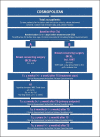Accelerated Partial Breast Irradiation: A New Standard of Care?
- PMID: 32398982
- PMCID: PMC7204849
- DOI: 10.1159/000506254
Accelerated Partial Breast Irradiation: A New Standard of Care?
Abstract
Background: Breast-conserving therapy including lumpectomy and adjuvant whole breast irradiation (WBI) has become the standard therapy for early-stage breast cancer (EBC). Without WBI, the recurrence rate is significantly increased. However, when selecting patients at a low a priori risk of local recurrence only a small breast-cancer-specific mortality benefit, but no overall survival improvement, was detected for WBI. As most recurrences occur close to the lumpectomy cavity, accelerated partial breast irradiation (APBI) delivered exclusively to a limited volume of tissue around the initial lumpectomy site, has gained increased attention and is now discussed as an alternative to WBI for selected EBC patients.
Summary: Numerous techniques for APBI (interstitial brachytherapy, external beam-based APBI, intraoperative radiotherapy, MR-guided radiotherapy) allow treatment delivery in a shorter period of time, and radiation oncologists expect to further reduce side effects by using these new techniques, with improvements in cosmetics and quality of life. In this review, we aim to describe the existing evidence for the feasibility and effectiveness of different APBI techniques used in modern radiotherapy.
Key messages: APBI has provided outcomes similar to WBI combined with potentially reduced toxicity. While appropriate patient selection persists to be crucial for acceptable recurrence rates, the precise definition of patients suitable for APBI remains a matter of discussion. As long-term data are often still lacking, special attention should be paid to late side effects and long-term outcomes. Decision-making on appropriate treatment techniques should take into account not only local control rates, but also the impact on the patient's quality of life.
Keywords: Accelerated partial breast irradiation (APBI); Breast cancer; External beam-based APBI; Interstitial brachytherapy; Intraoperative radiotherapy; MR-guided radiotherapy.
Copyright © 2020 by S. Karger AG, Basel.
Conflict of interest statement
The authors have no conflicts of interest to declare.
Figures


Similar articles
-
Accelerated Partial Breast Irradiation (APBI): Where Are We Now?Curr Breast Cancer Rep. 2020;12(4):275-284. doi: 10.1007/s12609-020-00384-x. Epub 2020 Oct 18. Curr Breast Cancer Rep. 2020. PMID: 33101597 Free PMC article. Review.
-
Current modalities of accelerated partial breast irradiation.Nat Rev Clin Oncol. 2013 Jun;10(6):344-56. doi: 10.1038/nrclinonc.2013.65. Epub 2013 Apr 30. Nat Rev Clin Oncol. 2013. PMID: 23629470 Review.
-
Accelerated partial breast irradiation: An update on published Level I evidence.Brachytherapy. 2016 Sep-Oct;15(5):607-15. doi: 10.1016/j.brachy.2016.06.007. Epub 2016 Jul 27. Brachytherapy. 2016. PMID: 27475478 Review.
-
Toxicity of external beam accelerated partial-breast irradiation (APBI) in adjuvant therapy of early-stage breast cancer: prospective randomized study.Radiat Oncol. 2024 Feb 3;19(1):17. doi: 10.1186/s13014-024-02412-x. Radiat Oncol. 2024. PMID: 38310249 Free PMC article. Clinical Trial.
-
Late side-effects and cosmetic results of accelerated partial breast irradiation with interstitial brachytherapy versus whole-breast irradiation after breast-conserving surgery for low-risk invasive and in-situ carcinoma of the female breast: 5-year results of a randomised, controlled, phase 3 trial.Lancet Oncol. 2017 Feb;18(2):259-268. doi: 10.1016/S1470-2045(17)30011-6. Epub 2017 Jan 14. Lancet Oncol. 2017. PMID: 28094198 Clinical Trial.
Cited by
-
Risk factors and specific cancer types of second primary malignancies in patients with breast cancer receiving adjuvant radiotherapy: a case-control cohort study based on the SEER database.Am J Cancer Res. 2022 Jun 15;12(6):2744-2756. eCollection 2022. Am J Cancer Res. 2022. PMID: 35812050 Free PMC article.
-
Stereotactic body radiotherapy using CyberKnife versus interstitial brachytherapy in accelerated partial breast irradiation on left-sided breast: A comparison of dosimetric characteristics and preliminary clinical results.Breast. 2024 Dec;78:103796. doi: 10.1016/j.breast.2024.103796. Epub 2024 Sep 4. Breast. 2024. PMID: 39243564 Free PMC article.
-
Use of Radiation Therapy for the Treatment of Breast Cancer in 2019 Versus 2020.Adv Radiat Oncol. 2023 Dec 30;9(4):101435. doi: 10.1016/j.adro.2023.101435. eCollection 2024 Apr. Adv Radiat Oncol. 2023. PMID: 38778830 Free PMC article.
-
A meta-analysis of the efficacy and safety of accelerated partial breast irradiation versus whole-breast irradiation for early-stage breast cancer.Radiat Oncol. 2021 Feb 2;16(1):24. doi: 10.1186/s13014-021-01752-2. Radiat Oncol. 2021. PMID: 33531014 Free PMC article. Review.
-
Factors Associated With Cosmetic Outcomes After Treatment With a Novel Form of Breast Intraoperative Radiation Therapy.J Surg Res. 2023 Mar;283:514-522. doi: 10.1016/j.jss.2022.10.077. Epub 2022 Nov 24. J Surg Res. 2023. PMID: 36436288 Free PMC article.
References
-
- Marta GN, Hanna SA, Martella E, Silva JL, Carvalho Hde A. Early stage breast cancer and radiotherapy: update. Rev Assoc Med Bras (1992) 2011 Jul-Aug;57((4)):459–64. - PubMed
-
- Poortmans P. Evidence based radiation oncology: breast cancer. Radiother Oncol. 2007 Jul;84((1)):84–101. - PubMed
-
- Veronesi U, Cascinelli N, Mariani L, Greco M, Saccozzi R, Luini A, et al. Twenty-year follow-up of a randomized study comparing breast-conserving surgery with radical mastectomy for early breast cancer. N Engl J Med. 2002 Oct;347((16)):1227–32. - PubMed
-
- Fisher B, Anderson S, Bryant J, Margolese RG, Deutsch M, Fisher ER, et al. Twenty-year follow-up of a randomized trial comparing total mastectomy, lumpectomy, and lumpectomy plus irradiation for the treatment of invasive breast cancer. N Engl J Med. 2002 Oct;347((16)):1233–41. - PubMed
-
- van Dongen JA, Bartelink H, Fentiman IS, Lerut T, Mignolet F, Olthuis G, et al. Randomized clinical trial to assess the value of breast-conserving therapy in stage I and II breast cancer, EORTC 10801 trial. J Natl Cancer Inst Monogr. 1992;((11)):15–8. - PubMed
Publication types
LinkOut - more resources
Full Text Sources
Research Materials

